Category: news
New research carried out by the American Academy of Sleep Medicine, shows that there is a significant correlation between artificial light exposure at night and insomnia. The findings suggest that increasing levels of artificial, outdoor light exposure at night is linked to insomnia in older adults
Recent research by the American Academy of Sleep Medicine highlights a significant link between nighttime exposure to artificial light and insomnia. This research shows that increased exposure to artificial light outside at night correlates with higher rates of insomnia in older adults. Consequently, these individuals tend to use prescription sleep medications for extended periods or in higher doses because of light pollution.
The overall results suggest that sleep deprivation indoor or outdoor light pollution may cause insomnia or contribute to sleep deprivation. The study results are published in the November issue of the Journal of Clinical Sleep Medicine.
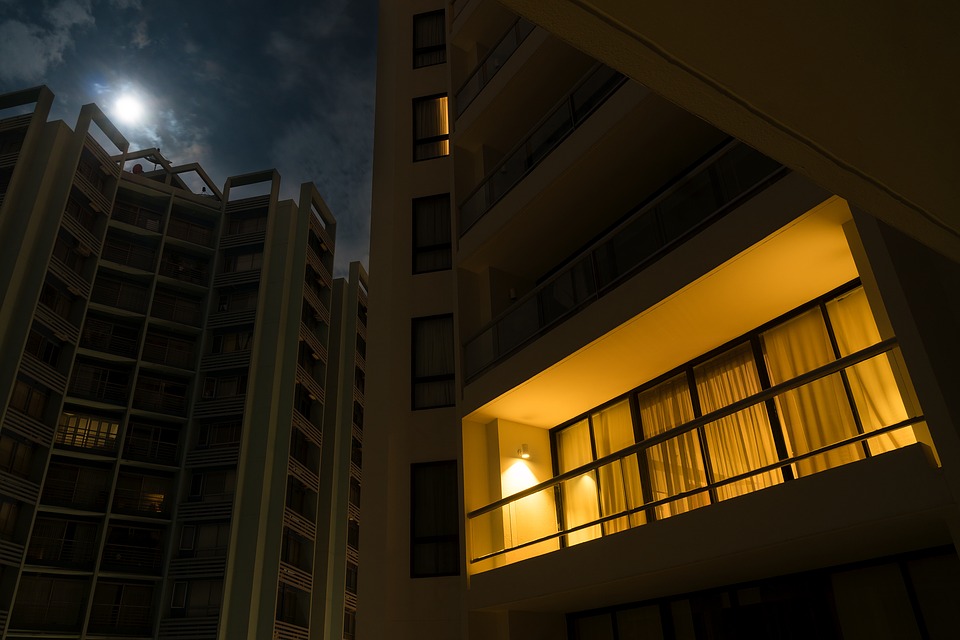
According to the researchers at the American Academy of Sleep Medicine, insomnia involves struggling to fall asleep, having difficulties in maintaining sleep and waking up too early. It’s well known that environmental factors, such as light, extreme temperatures, noise and similar can disrupt one’s sleep.
The authors of the study suggest that inappropriate or excessive use of artificial light at night, also called light pollution, can significantly affect the quality of one’s sleep. Research has shown that exposure to artificial nighttime light can disrupt circadian rhythms, and speaking long-term, potentially lead to metabolic and chronic diseases, such as depression, diabetes, and obesity.
The study was conducted by examining the data from (NHIS-NSC). The sample was taken from a population in South Corea. The researchers analyzed the data from 2002 to 2013 and excluded everyone who was diagnosed with a sleep disorder. The final study sample comprised of 60% female and 40% male who were at least 60 years old. In order to determine the individual exposure level to artificial light, scientists used satellite data provided by the National Centers for Environmental Information.
Usage data for two prescription sleeping pills form the group of hypnotic drugs such as zolpidem and triazolam, were gathered from health insurance records. About 22% of subjects had prescriptions for hypnotic sleeping pills. Leading authors of the study believe that bright outdoor lighting may be one of the environmental causes that not only cause insomnia but also leads to prescribing hypnotic drugs. Further research is required to define and minimize the severe effects of light pollution on human health.
A new study has made a startling revelation: your preferred wakeup time could be jeopardizing your health. It appears that night owls, or those who stay up late, may be at a higher risk of … Read more
A new study has made a startling revelation: your preferred wakeup time could be jeopardizing your health. It appears that night owls, or those who stay up late, may be at a higher risk of developing heart problems and type 2 diabetes compared to early risers. The reason? People who are active at night tend to indulge in unhealthy snacks and fail to maintain consistent meal times. This significant finding was published in Advances in Nutrition on November 30. Take a closer look, and you’ll discover why changing your sleep pattern might just be the breakthrough you’ve been searching for.
Sleeping Preferences and Health
The human body runs on a 24-hour cycle is regulated by an internal body clock, also known as circadian rhythm. Our internal clock doesn’t only regulate sleep but also tells you when to eat, sleep and wake. Every circadian rhythm is unique and causes to forming a natural preference towards either waking up early in the morning or going to bed late in the evening. Scientists from the Northumbria University have found out that people with the evening chronotype (who go to bed late) have a higher chance of suffering from heart disease and type 2 diabetes.
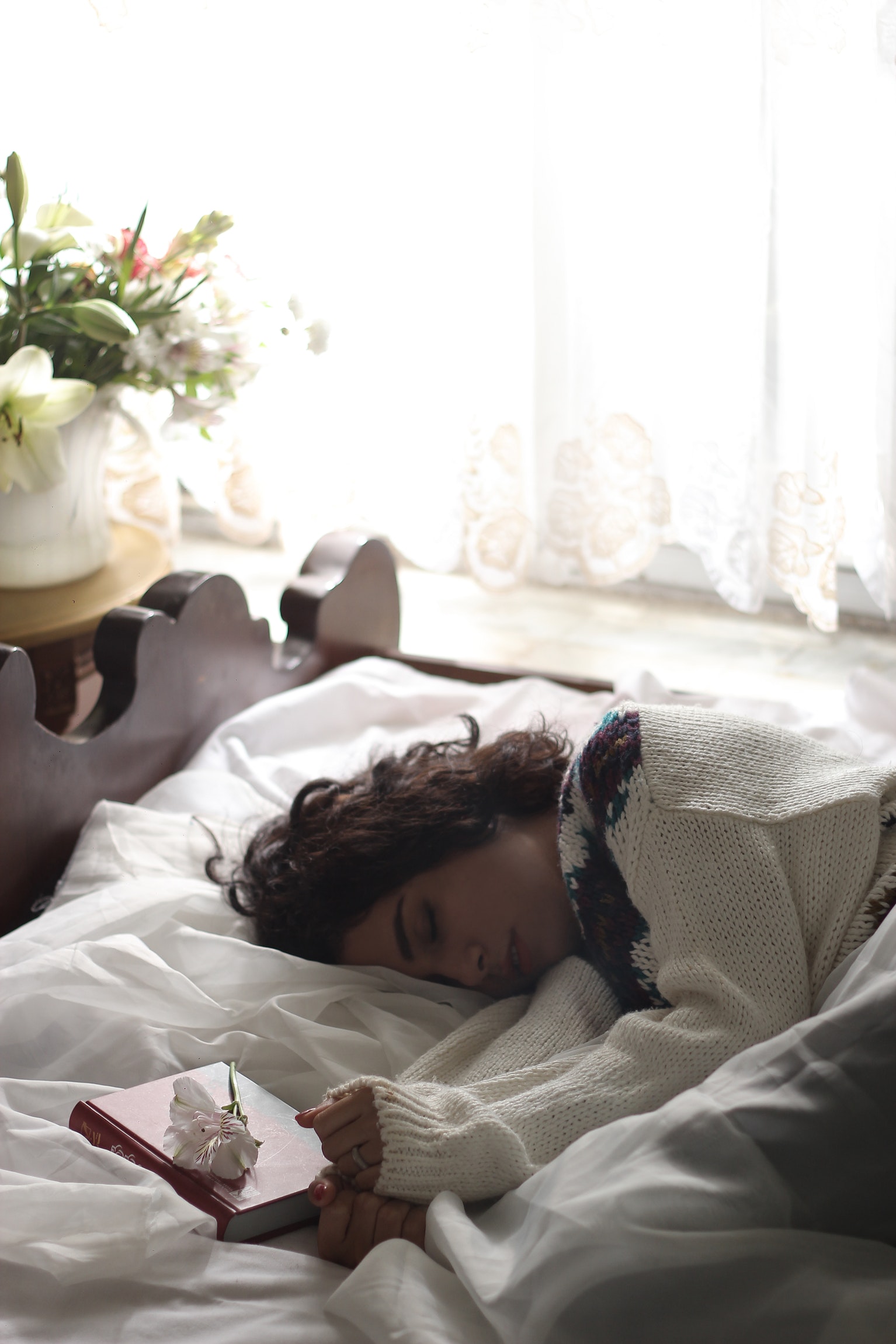
The risk is increased because the findings also indicate that night owls have unhealthier diets, consuming more alcohol, junk food, sugars and caffeinated drinks than early risers. Night owls report more erratic eating patterns, such as missing breakfast and eating later in the day. The diet of night owls contains less healthy food, especially grains, fresh fruits and vegetables, and their meals are typically larger than average. They also report consuming a lot of caffeinated drinks, fast food, sugar, and snacks.
On the flip side, early risers eat more fruits and vegetables, and have more meals but in smaller portions. The bad dietary choices may explain why night owls are more prone to suffering from chronic disease. Since the internal body clock also influences the way glucose is metabolized in the body, eating late in the day is also linked to an increased risk of type 2 diabetes. Night owls prefer eating before bed which leads to increased glucose levels. Naturally, glucose levels should be the lowest at night. When this is frequently done, it could negatively affect metabolism because it doesn’t follow the normal biological processes of the body.
This can also impact people who work shifts, particularly if their shifts rotate and they need to adjust their body to their working hours constantly. Doing so reduces their sensitivity to insulin and affects glucose tolerance, increasing their risk of type 2 diabetes.
The study also uncovered some interesting facts and trends. For example, people’s preferences to wake up early or go to bed late change at varying points in the life cycle. Most children are typically early risers until six years old, and become night owls during puberty. The evening often preferences last until an adult reaches their early fifties. After that, they begin to revert back to a morning chronotype.
Being exposed to daylight also influences sleep. Studies show that every additional hour spent outdoors brings 30 minutes of ‘advance sleep’. Lighting, noise, crowding of urban environments, and similar external factors can affect whether a person becomes an early riser or a night owl. Night owls typically accumulate ‘sleep debt’ during the working week and sleep longer at weekends to catch up. Early risers have small differences in their sleeping patterns across the entire week.
Further research aims to find out how people’s circadian rhythm affects their dietary habits and health in the long-term. Researchers will also try to identify the best methods to evaluate one’s chronotype, and how their sleeping preferences may impact one’s long-term cardiometabolic health.
Need more Natural Sleep?
Best White Noise Machine Reviews
Scientifically Backed Research and Help for Those Struggling To Sleep
[et_pb_button button_url=”#” button_text=”Sleep machine Ratings” _builder_version=”3.15″ custom_button=”on” button_text_color=”#44d89e” button_bg_color=”#ffffff” button_border_width=”0px” button_border_radius=”100px” button_font=”Poppins|600||on|||||” button_use_icon=”off” box_shadow_style=”preset1″ box_shadow_blur=”16px” box_shadow_color=”rgba(0,0,0,0.16)” background_layout=”dark” custom_margin=”|||”][/et_pb_button] [toc] 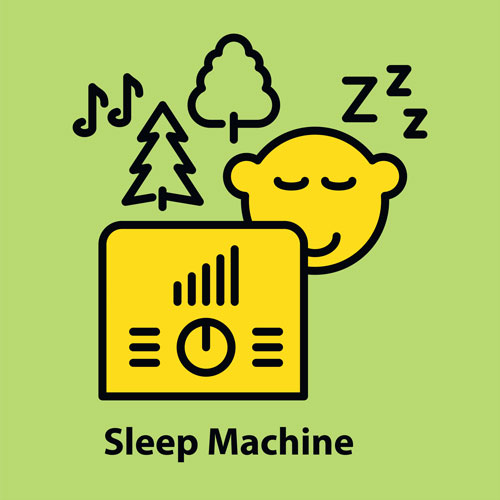 Due to rampant sleeping problems among many sleepers, many are now resorting to white noise machines. These devices produce sleep-inducing sounds to make the user fall asleep and remain asleep until he or she gets enough amount of rest.
Due to rampant sleeping problems among many sleepers, many are now resorting to white noise machines. These devices produce sleep-inducing sounds to make the user fall asleep and remain asleep until he or she gets enough amount of rest.
[toc]
Buying Guide
A sound machine, often referred to as a White Noise machine, serves mainly to aid in sleeping by emitting sounds that mask background noise or interruptions. It creates a kind of static, known as white noise, that consists of various random frequencies. Some versions come with features that allow for the playback of natural or environmental sounds, including the tranquil sound of a flowing river, the light raindrops falling, the whisper of leaves, and other relaxing sounds that are beneficial for unwinding into sleep and during sleep.
There are different varieties to choose from and more specific uses for White Noise machine. They are compact and designed to rest on floors or on bedside tables because of their flat surface.
Knowing which type of machine to pick is essential to better accommodate your needs and support your sleeping processes. When buying, ask yourself the following questions and consider these guidelines on your checklist:
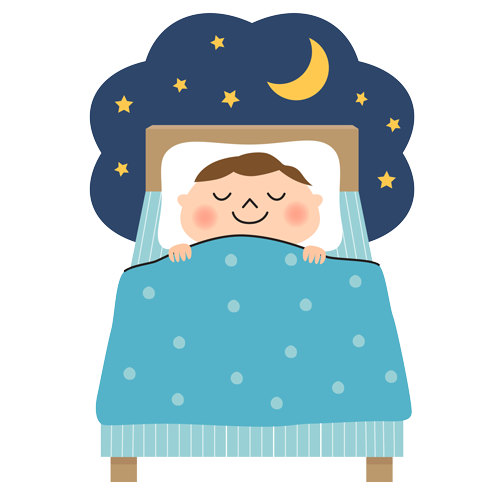
Product Utilization
- Identify who will primarily use the White Noise Machine
-
Determine whether you need a device exclusive for home use or office use
- Know if the product is good for travel too or if it’s worth space in your luggage.
- Be specific when picking a White Noise Machine, it should serve the purpose of why you are buying in the first place (e.g. Tinnitus remedy, snore masking, deep slumber, etc).
Size and Space Matters
- If you need mobility, pick machines that can be easily moved or carried.
- Determine if the machine will fit in the place you intend to install it.
- When traveling, pick machines that weigh the lightest and use batteries.
Product Features and Accessories
- To save less electricity and avoid overusing the machine, look for one that includes timer features and control programs to help you set consumption limit.
- Test the sound features of the machine if it suits your liking and needs for relaxation.
- Identify if you will need additional accessories for your White Noise machines such as remote control or other plugs.
Durability and Affordability
- The machine should be viable for long-term use so inspect quality when buying.
- Decide on how you would like your machine to be powered, either batteries or plugs.
- Weigh in with the cost of the machine and gauge into the warranty coverage for it.
Picking the right white noise machine shouldn’t be difficult for you after referring to some of these guidelines. Tick off your checklist and narrow your options. It is important to know what you are getting at and not compromise your money and quality of your sleep.
Best White Noise Machine for Sleep
LectroFan
Best Sound Machine For General Use
White Noise machine has become one effective sleeping aid for many people. The sound waves in a broad spectrum of frequencies produced by the White Noise machine help people to sleep through the night. It masks the disturbances brought by inevitable squeaking sound either coming from your house or the ear-splitting sound of a passing vehicle. The machine improves the process of sleeping and its ability to remain asleep during the night.
Generally, the sleep sounds produced by the machine can be classified into different types of color noise. In audio engineering, a color noise refers to the power spectrum or the distribution of power into frequency components that thereby compose signal. Color noises include pink, brown, and white relevant to the machine. To understand white noise, think of the static sound of an old television or radio when nothing is playing or broadcasting. That is one example of white noise, and it is a mixture of all frequencies that a human ear can hear. Therefore, since it is a combination of all frequencies, all other sounds in the path tend to disappear.
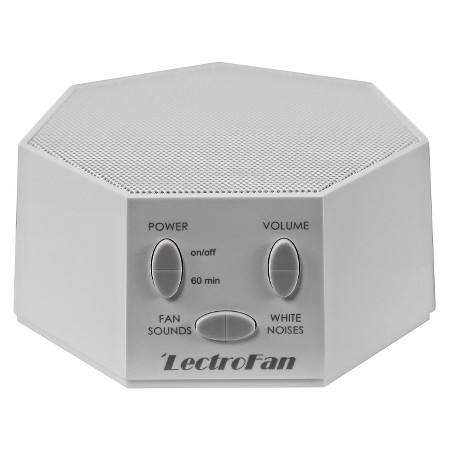 [et_pb_button button_url=”https://www.countingsheep.net/product/lectrofan/” url_new_window=”on” button_text=”Shop on Amazon” button_alignment=”center” _builder_version=”3.15″][/et_pb_button][et_pb_tabs _builder_version=”3.15″][et_pb_tab title=”Product Summary” _builder_version=”3.15″]
[et_pb_button button_url=”https://www.countingsheep.net/product/lectrofan/” url_new_window=”on” button_text=”Shop on Amazon” button_alignment=”center” _builder_version=”3.15″][/et_pb_button][et_pb_tabs _builder_version=”3.15″][et_pb_tab title=”Product Summary” _builder_version=”3.15″]
LectroFan white noise machine provides excellent sound quality in a wide range of different white noise and fan sounds. It utilizes state of the art technology in generating dynamic, realistic sounds to drown out unwanted, upsetting, or interfering noises. This machine has two ways to reduce unwanted noises: either through a fan or white noise sounds themselves.
What makes it a standout is its 20 different sounds, encompassing 10 different white noise sounds including a variety of colors like pink and brown. It also has 10 different fan sounds with some that are soft and gentle and others are more industrial, all of which are dynamically generated, not recorded. It results to more constant authentic sounding white noise. With the different varieties of the sounds, many people find it more relaxing as it caters to every taste of the ears.
The LectroFan’s 10 white noises range from “dark noise” or the low frequency to “white noise” or high frequency with sound variations of low rumbles, rushing wind, or static – neither pleasant nor unpleasant.
Aside from the sounds it has, it masks disruptive noises that made you fall asleep with ease. It blocks out noisy neighbors, household, traffic or construction noise, lullababies to sleep, create a disturbance-free study area, and keep conversations private.
With the machines inside equipment, it makes it safe, energy efficient, and long-lasting alternative to fans or white noise machines with motors. LectroFan does not contain moving parts inside it. Above all else, it has over 50 volume levels in 1dB increments which makes it ideal for the level of volume you wanted to habituate
[/et_pb_tab][et_pb_tab title=”Pro’s and Cons” _builder_version=”3.15″]
| Pros | Cons |
| It has 20 different fans and white noise sounds including pink and brown noise. | The power cord is a bit short. |
| It has high quality, dynamically generated sounds that have no looping or breaks. | Needs to be plugged in as there is no battery option. |
| It has high quality, dynamically generated sounds that have no looping or breaks. | Only one timer setting of 60 minutes. |
| Excellent speaker and volume range that is fully adjustable. | The machine may not work for those with sensitive ears or those who dislike motor hum of real fans. |
| Volume is louder than other sound machines. | May not be sufficient for noises at close range like snoring. |
[/et_pb_tab][/et_pb_tabs]
The sound produced by a White Noise machine is also compared to the sound of a waterfall, with water falling at different speeds and hitting different surfaces. The sound spectrum, however, tells us that all colors besides white noise are also similar to white noise but just with more energy to drown out all other sounds. When using a white noise machine, you could even be listening to a pink noise as well which would sound more like a heavy rainstorm.
Using the product should be able to afford you the calm and focus you need to help deviate your mind from any form of distraction upon sleeping. Sleeping is very important as this is where our brain takes in more oxygen and ready you for the next physical activities of your day.
Best White Noise Machine For Babies
Baby Shusher Sleep Miracle Soother
White noise machine is excellent to help babies drift off to sleep. Scientifically, in the ears of babies, white noise is a familiar sound to them. It is because white noise mimics the womb sound that soothes and comfort them while they are inside their mother’s womb.
Furthermore, the consistent sound made by the machine soothes baby’s sleep. If they have slept tightly already, while using white noise, it can lengthen the baby’s nap.
If you have a newborn, since babies do not have sleep training yet after seeing the outside world, the white noise machine can help them get enough sleep they still needed, at the same time, they are building their sleeping schedule. Aside from these, there are other advantages that a mother could get when using a white noise machine for their babies. It includes the reduces the risks of SIDS, calms babies from crying, and shush babies.
 [et_pb_button button_url=”https://www.countingsheep.net/product/baby-shusher/” url_new_window=”on” button_text=”Shop on Amazon” button_alignment=”center” _builder_version=”3.15″][/et_pb_button][et_pb_tabs _builder_version=”3.15″ tab_font=”||||||||”][et_pb_tab title=”Product Summary” _builder_version=”3.15″]
[et_pb_button button_url=”https://www.countingsheep.net/product/baby-shusher/” url_new_window=”on” button_text=”Shop on Amazon” button_alignment=”center” _builder_version=”3.15″][/et_pb_button][et_pb_tabs _builder_version=”3.15″ tab_font=”||||||||”][et_pb_tab title=”Product Summary” _builder_version=”3.15″]
The Baby Shusher has a white noise in the form of shushing sound. This baby sound machine has a rhythmic and repetitive shush which mesmerizes infants and toddlers. The shushing sound mimics the atmosphere that the baby was accustomed to in the womb, with the blood flowing through its mother’s body and the muffled sounds from the outside world.
The Baby Shusher has one sound profile that masks outside noises so well to give babies smooth sleep while hearing a realistic womb sound produced by the machine. The machine was proven the best performer as it resulted in the test that the shushing sound produced by the device has a perfect frequency for masking high-pitched noises like a vacuum.
[/et_pb_tab][et_pb_tab title=”Pro’s and Cons” _builder_version=”3.15″]
| Pros | Cons |
| Rhythmic and realistic shush of the machine reminds baby of being
inside mom with 15 – 30 minutes of continuous shushing sound. |
The sound ends too abruptly when the time reaches the end. |
| Wrist straps for parents t1o assist parents while putting their
babies to sleep |
No continuous play option. |
| Versatile, portable, and durable because it is small and compact
making it suitable for traveling. |
Only one timer setting of 60 minutes. |
| 3.2 ounce in weight | The sound ends too abruptly when the time reaches the end. |
[/et_pb_tab][/et_pb_tabs]
Babies struggle to sleep deeply through the night because they have not yet mastered the ways of deep slumber. There are common factors why they are kept awake such as hunger, wet pads or diapers, room temperature, and environment. The babies constantly need feeding, changing diapers, cozying, and protecting. Otherwise, parents will have to induce a sense of drowsiness for them. It could either be through scheduled sleeping or sleep training with the use of machines that alert the sound of lullaby that signals them to sleep. This is where White Noise Machines for babies becomes handy.
Best White Noise Machine Tinnitus
Sound Oasis S-100
Best Tinnitus Sound Therapy Machine
Tinnitus refers to the condition wherein one or both ears of a person perceives sound even when no external sound is not present. There is a perception of pesky noise or ringing in the ears, and it affects about 1 in 5 people, making it a common problem. There is said to be no proven cure for tinnitus but understanding the symptoms of or factors leading to it could help in easing the problem. Some people would go for meditation while others seek devices like White Noise machines or hearing aids.
For others, to better manage and block the sound at night, White Noise Machine’s function applies. White Noise is known to operate in a combination of frequencies that blocks out any inconsistent sound coming in the way. The problem is not the noises in the environment but rather the sudden change in the frequency or strength of the sound that makes it distracting. For people with tinnitus, they could get better aid from the use of White Noise machine to relax their sound perceptions at night and be able to have a restful sleep. In one report, a white noise generator has been found to significantly reduce unwanted sound, and get rid of it altogether in some cases.
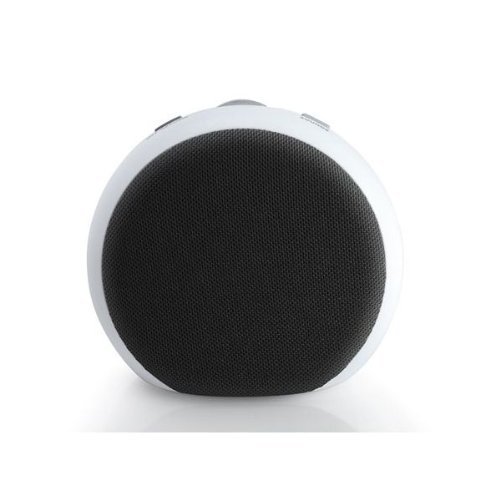 [et_pb_button button_url=”https://www.countingsheep.net/product/sound-oasis-s-100-2/” url_new_window=”on” button_text=”Shop on Amazon” button_alignment=”center” _builder_version=”3.15″][/et_pb_button][et_pb_tabs _builder_version=”3.15″ tab_font=”||||||||”][et_pb_tab title=”Product Summary” _builder_version=”3.15″]
[et_pb_button button_url=”https://www.countingsheep.net/product/sound-oasis-s-100-2/” url_new_window=”on” button_text=”Shop on Amazon” button_alignment=”center” _builder_version=”3.15″][/et_pb_button][et_pb_tabs _builder_version=”3.15″ tab_font=”||||||||”][et_pb_tab title=”Product Summary” _builder_version=”3.15″]
The Sound Oasis S-100 Noise White Machine is developed for those with tinnitus. It helps to beat the discomfort from tinnitus discomfort while blocking out irritating noises at the same time. This is the ultimate latest generation technology noise machine that provides ten different tones of white noise although it is a patent-pending technology. Its white noise sound options range from lower to higher-pitched sounds for perfect tone selection.
The machine comes in small size, but the quality of sound is superb. It is suitable for blocking out distractions. It has unique features which include a jack where you can plug in any device such as MP3, laptop, desktop, smartphones, and others. This is ideal for choosing what pitch you want to play to block out the noise from tinnitus and other disturbances.
The Sound Oasis S-100 effectively masks unwanted noise and creates serenity to the person making his or her sleep far comfortable.
[/et_pb_tab][et_pb_tab title=”Pro’s and Cons” _builder_version=”3.15″]
| Pros | Cons |
| 4- position auto-off timer: 30, 60, 90 minutes in a continuous play | Does not play nature sounds natively |
| An easy-to-use rotary volume control dial | |
| Big 3-inch speaker with high-quality sound | |
| Energy sufficient in which it runs day and night but consumes only 1% of the electricity. | |
| Can be connected to a sound player like smartphones, tablets, MP3 and other else. |
[/et_pb_tab][/et_pb_tabs]
White Noise machines or devices for people with tinnitus condition may come at the different shape. Some devices are looking like hearing aids worn behind the ears. This way, the brain eventually gets used to the constant cascade of noises that it tones down reactions. It’s time to discover what devices are available for you in the market to better manage tinnitus.
Best White Noise Machine for Snoring
Sound + Sleep
Best Sound Machine for Excessive Snoring
There is no shame in using a White Noise Machine to mask the sound of your partner’s snore or that of whoever you share a room with. After all, White Noise machine is there to serve as a consistent audio backdrop to eliminate annoying noises. A noisy environment is not conducive for sleeping, and so is loud snoring.
A person snores when the air can’t move freely from the nose to the throat during sleep. It can be destructive to the health of the person snoring as it is likely to disrupt the quality of sleep which leaves the person fatigued and irate, which could also develop further health complications when it is persistent. Snoring may have something to do with the floppy nasal and throat tissues. These tissues tend to hand or flop loosely thereby creating a vibrating sound. In other cases, it could also be the tongue that’s getting in the way of leveled breathing.
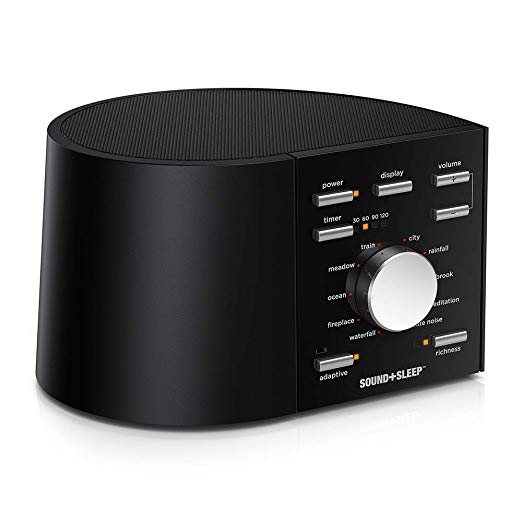 [et_pb_button button_url=”https://www.countingsheep.net/product/sound-sleep/” url_new_window=”on” button_text=”Shop on Amazon” button_alignment=”center” _builder_version=”3.15″][/et_pb_button][et_pb_tabs _builder_version=”3.15″ tab_font=”||||||||”][et_pb_tab title=”Product Summary” _builder_version=”3.15″]
[et_pb_button button_url=”https://www.countingsheep.net/product/sound-sleep/” url_new_window=”on” button_text=”Shop on Amazon” button_alignment=”center” _builder_version=”3.15″][/et_pb_button][et_pb_tabs _builder_version=”3.15″ tab_font=”||||||||”][et_pb_tab title=”Product Summary” _builder_version=”3.15″]
The Sound + Sleep Sound Machine is a high fidelity white noise machine that is loaded with a recording option. Users can listen to white, pink, and brown noise with a wide selection of natural and environmental sounds. It has 10 sound profiles and 30 unique add-on listening experiences. It weighs two pounds and measures less than five inches tall.
The Sound + Sleep Sound Machine offers a good deal of versatility. It can detect other noises in your environment, whether it’s the neighbor’s howling dog, a snoring roommate or housemate, and unwanted screech. Once it detects these disturbances, the machine adjusts to cover them.
This device also has what it calls “richness” feature; it is unique as it allows the user to add more details on each of the 10 Soundscapes. For instance, when you choose to play the sound of the “ocean,” you will mainly hear breaking waves. However, if you press to control the richness of the sound, it will add up the sound of birds’ and seals that add flavor to the music that you are listening. On top of that, the machine is also able to adapt to the sound. As the surrounding noise increases, so will the volume increases too, to accommodate masking it.
The machine also has a noise-reduction timer which can be programmed in 30-, 60-, 90-, and 120- minute increments. This gradually enhances the white noise sleeping experience. At the same time, it also allows for private listening with a headphone as it has a headphone jack available.
[/et_pb_tab][et_pb_tab title=”Pro’s and Cons” _builder_version=”3.15″]
| Pros | Cons |
| It has a vast variety of sound options. You can choose among white, pink, and brown noise with 9 base environmental sounds. | It is the most expensive white noise machine. |
| It has “richness” feature which can be added to create more variety. | It only works with a standard plug. |
| It has long 30 minutes recordings, so there are no noticeable loops. |
|
| It has an excellent speaker and recording quality which provides realistic sounds. | |
| There is an available headphone jack for private listening.
|
[/et_pb_tab][/et_pb_tabs]
Much as it is destructive to the health of the person who is snoring, it is just as disruptive to the person who is continuously woken up due to the snore. Snores can be loud and annoying therefore affecting the quality of sleep of one’s partner in the room. Quality sleep is very much necessary for the better functioning of the brain and body. If the snoring couldn’t be helped immediately.
White Noise machines are a useful remedy for the distraction brought about the snore. It will help mask the noise coming from the snore as well as other unavoidable noises. There are affordable White Noise machines and devices out there that are neither noninvasive and complicated. Check out some of the products from the thousands available to potentially save both quality sleep and relationship.
Best White Noise Machine for Office
Marpac DOHM DS
Best Sound Machine for Office Work
The office can be a toxic and stressful environment too, especially if you work in a cubicle where you could hear all types of chatters and noises. The conversations and the noises you hear around your office floor may not be very supportive of your deal to concentrate on your tasks and work. In some cases, even in a confined room for office, conversations that are supposed to be private may still be heard outside of the limited space thereby breaching the confidentiality of the discussions.
In these cases, sound machines such as White Noise machine is a helpful tool. Not to mention, it can be an added benefit to concentration, relaxation, and privacy. Those who need to mask distracting noises of office surrounding may make use of white noise machines that has a headphone jack so you could have the therapeutic sound all by yourself in your cubicle.
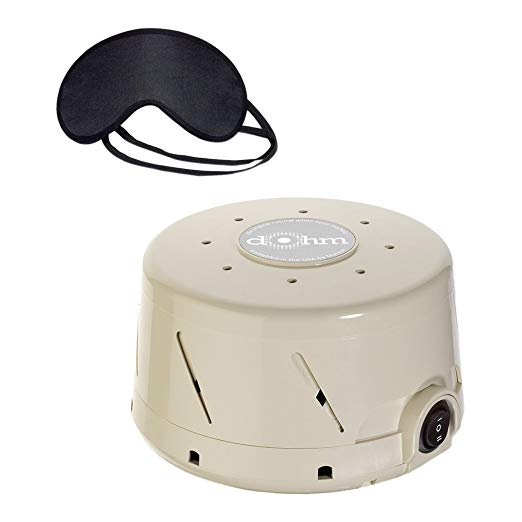 [et_pb_button button_url=”https://www.countingsheep.net/product/marpac-dohm/” url_new_window=”on” button_text=”Shop on Amazon” button_alignment=”center” _builder_version=”3.15″][/et_pb_button][et_pb_tabs _builder_version=”3.15″ tab_font=”||||||||”][et_pb_tab title=”Product Summary” _builder_version=”3.15″]
[et_pb_button button_url=”https://www.countingsheep.net/product/marpac-dohm/” url_new_window=”on” button_text=”Shop on Amazon” button_alignment=”center” _builder_version=”3.15″][/et_pb_button][et_pb_tabs _builder_version=”3.15″ tab_font=”||||||||”][et_pb_tab title=”Product Summary” _builder_version=”3.15″]
Marpac DOHM DS is a consistent best seller in many online stores owing to its excellent reviews. The device has a professional appearance that does not pass up at the expense of your office’s aesthetics. It is suitable for office use since it blocks out a more abundant source of noise (ex. Crowd, Office cubicles) compared to other devices. It produces a full, rich, and wide-ranged white noise sound.
A small fan is built inside an acoustic chamber of the machine. Also, it allows you to adjust the volume between two speeds set. You can customize the volume and tone by changing the speed sound openings of the device for your satisfaction. In doing so, you can control how the sound hole openings will cap volumes. If the low-speed setting is used, the device will not require a lot of power to run while providing a soothing white noise tone. The fan will continue to run as the sound echoes out of the device.
[/et_pb_tab][et_pb_tab title=”Pro’s and Cons” _builder_version=”3.15″]
| Pros | Cons |
| Very professional appearance | The machine’s motor sound may seem annoying and too loud for the first time usage of the products |
| It creates authentic fan sounds with an internal fan | It can only be operated through electrical cord because there is no battery option available |
| It creates a constant noise that does not change, loop or break | It does not have nature sounds |
| It has a simple switch design | No auto-off timer |
| The user can fine-tune it to create a satisfying sound you like
|
[/et_pb_tab][/et_pb_tabs]
Meanwhile, making sure that the conversations are kept more private inside the room may also benefit from the sound that the machine produces. As it goes, White Noise machines operate at a combination of frequencies making other noises to be heard from the dominance of the sound it produces. There are many more products to choose from, check out some of the items that you could use or possibly share in the office.
Best White Noise Machine for Travel
Big Red Roster
Best Sound Machine for People On The Go
For people traveling out of town, it may not always be comfortable to sleep on a new, unfamiliar bed and room. The location may also add to the unpredictability of disturbances as foreign sounds and noises may bewilder you late at night. Sleeplessness doesn’t have to be the case when you are far away from home.
White Noise machines are useful tools for deep continuous sleep that can also be handy when traveling outside of town. Save yourself from the unwanted beats of your music-loving neighbors or a late-night television watcher next to your motel. A White Noise machine allows you to mask unwanted noises from the new neighborhood or the loud footsteps coming from the hotel hallway.
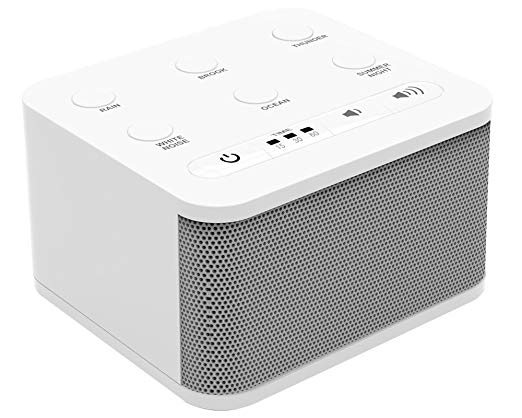 [et_pb_button button_url=”https://www.countingsheep.net/product/big-red-rooster-white-noise-machine/” url_new_window=”on” button_text=”Shop on Amazon” button_alignment=”center” _builder_version=”3.15″][/et_pb_button][et_pb_tabs _builder_version=”3.15″ tab_font=”||||||||”][et_pb_tab title=”Product Summary” _builder_version=”3.15″]
[et_pb_button button_url=”https://www.countingsheep.net/product/big-red-rooster-white-noise-machine/” url_new_window=”on” button_text=”Shop on Amazon” button_alignment=”center” _builder_version=”3.15″][/et_pb_button][et_pb_tabs _builder_version=”3.15″ tab_font=”||||||||”][et_pb_tab title=”Product Summary” _builder_version=”3.15″]
The Big Red Rooster white noise machine is highly recommended for those who travel as it uses three AA batteries to power it. It is portable, making it a convenient device to bring on trips or vacations. You can keep it all night or set it on a timer for about 15, 30, or 60 minutes. The machine offers six high-quality natural sounds which include rain, brook, ocean, thunder, white noise, and summer night. Also, the device is tiny and compact. It only weighs less than 10 ounces and measures less than three inches high.
The machine has six sounds to choose from including the rain, ocean, brook, thunder, and thunderclap, as well as summer night sounds. The rain sound and the ocean sound are rather soothing in the ears as it is much gentle compared to the other sounds. The brook sound, on the other hand, produces a nice short loop, making you listen to the same pattern. The thunder sound is mainly light rain with occasional thunder. And just like the brook, the sound it produces has reasonable loops of a few different thunderclaps. Meanwhile, the summer night sounds have this faint white noise in the background.
The device has well-labeled buttons that is helpful for anyone to operate it efficiently. Overall, the flimsy plastic design of the machine makes it compact and lightweight at the same time. Its simple built does not compromise the speaker quality or the noise of the device.
[/et_pb_tab][et_pb_tab title=”Pro’s and Cons” _builder_version=”3.15″]
| Pros | Cons |
| Easy to use because of its big buttons | It is only limited to 6 sounds |
| It has a couple of the nature sounds which are pleasant to listen | Some of the nature sounds are on a short loop which might be disruptive for some people |
| It can be powered by a USB plug or with three AA batteries | The maximum volume might not be enough to mask the external noise |
| It is convenient and comfortable even when traveling with kids.
|
[/et_pb_tab][/et_pb_tabs]There are varieties of White noise machines that are light and compact, so it’s good for travel options. Restful sleep is always worth that space in your luggage, so check out some of the recommendations for best White Noise Machine travel companion.
Alternatives for White Noise Machines
Some sleepers prefer not to invest in a white noise machine because of personal or financial reasons. There are of course other effective methods of blocking those external noises that hinder a good sleep. While White Noise machines emit sounds that conceal any possible sound disturbances or change in tones, there are smart home devices or accessories to choose from to protect one from ear-splitting noises at night.
White Noise Mobile Apps – Android/iPhone
Not everyone has the luxury to provide a space for everything in their suitcase or some other reasons, but that shouldn’t put comfort and promising sleep in a compromised position. The good thing is, in the digital age, White Noise Apps are also made available so you could play them at the tip of your fingers.
White Noise apps for mobile devices, depending on your OS, may include free tracks of several natural sounds and white noises that could also play in multiple devices. Some Apps could give you a good collection of audio and white noise. If you want to have a further guarantee, some apps may also offer you in-app purchases so you could go for Pro version with more extensive collections of sounds to choose from. There are also apps that provide parental control for the use of the sounds. From friendly lullabies and white noise for babies sleep to that of relaxing melodies, choices are never limited to explore for your promise of rest.
Conventional Fans
Aside from the fact that it could lessen the heat inside the bedroom, and its primary purpose to improve air circulation and create a more relaxed space during warmer times, the whizzing blades of conventional fans could produce ambient white noise that can be a substitute for the other disturbing and disruptive sounds.
Facts About White Noise and Sound Machines
White noise is typically a particular type of sound that is used for masking the background sounds. It is described as a noise that has an amplitude which is constant throughout the audible frequency range. It drowns the sounds that prevent a person from falling asleep or waking up during the momentum of sleeping.
The purpose of the white noise machine includes blocking annoying sounds, relaxation, and concentration.
With the help of white noise machine, it helps you have a better sleep by blocking out disturbing sounds. It could be very beneficial for light sleepers who are easily awakened by external sounds and for people who have trouble falling asleep because of the noisy surroundings.
Also, it could help babies relax and you, yourself, could have inner relaxation. Many people find the sound of oceans, rivers, forests, waterfalls, and rain calming, relaxing, refreshing, pleasing, and peaceful in the feeling. So taking a bit of listening to this sound with eyes closed could help you relax even if you are not in the actual setting.
Lastly, it can help you concentrate even just for a while. The white noise stops you from being distracted. Other studies testified that it could improve concentration.
How does White Noise Work?
The sound we hear from just about anything has distinct components; the frequency or the number of vibrations the sound wave produces per second which is measured in hertz or Hz and amplitude which is measures the size of the sound waves. If the frequency is halved or doubled, it is considered octave.
The noise we hear is categorized by colors which represent different audio signals and textures. These colors include pink, blue, and brown. These noises refer to sound waves that have an increase or decrease in volume but still dependent on the changes in the frequency.
On the other hand, white noise has maintained the volume regardless of the changes in frequency. It means, it is not dependent on the frequency. It randomly combines every possible frequency that is audible to the human ear. That is why the result associated with white noise is commonly the “shhh” sound which parents or storytellers do.
To better understand how the categorizations of noise color work, most especially how the frequency affects the volume of the sound, the table below details a comprehensive answer.
| Noise Color | How the Frequency Affects the Volume of the Sound | Possible Examples Reflected in the noise machine |
| Violet | The volume increases by 6 dB per octave. | Whistling Kettle |
| Blue | The volume increases by 3 dB per octave. | Hissing or High Wind |
| Brown or Red | The volume decreases by 6 dB per octave. | Waves or Low Winds |
| Pink | The volume decreases by 3 dB per octave. | Thunder |
| Grey | The volume decreases between 100 and 1,000 Hz, and increases between 5,000 and 10,000 Hz | Static with volume that remains constant |
| White | The volume remains constant even if the frequency increases or decreases. | High-pitched static |
| Black | No volume or whatsoever | Silence |
Safe Use Guide
Even if it is mentioned earlier that using noise machine can be addictive, it does not mean the user will be dependent upon the withdrawal of the noise machine. Thus, in using the white noise machine, rest assured that it offers health risk-free to the users.
If you have tried already building a good sleeping habit by cutting back on caffeine and having a regular bedtime routine, it does not make your sleep still enough. Talk to your healthcare provider if necessary. Your health care provider may rule out sleep apnea which can have the same symptoms of fractured sleep, or difficulty falling asleep as insomnia.
[et_pb_blurb title=”Better Sleep Guide” url=”https://www.countingsheep.net/how-to-sleep-better/” image=”https://www.countingsheep.net/wp-content/uploads/2018/05/sleep-icon.png” admin_label=”Class” _builder_version=”3.0.106″ header_font=”Poppins|600|||||||” header_text_align=”center” header_text_color=”#486066″ header_font_size=”18px” header_line_height=”1.3em” body_font=”Open Sans||||||||” body_text_align=”center” body_text_color=”#486066″ body_font_size=”14px” body_line_height=”1.8em” background_color=”#ffffff” border_radii=”on|6px|6px|6px|6px” box_shadow_style=”preset1″ box_shadow_vertical=”10px” box_shadow_blur=”24px” box_shadow_spread=”6px” box_shadow_color=”rgba(0,0,0,0.06)” custom_margin=”|||” custom_padding=”40px|30px|40px|30px” animation_style=”fade” animation=”off”]
Enjoy better sleep at night, improve your mental and physical health, as well as how you think and feel during the day.
[/et_pb_blurb][et_pb_blurb title=”Sleep Condition Research” url=”https://www.countingsheep.net/research/” image=”https://www.countingsheep.net/wp-content/uploads/2018/05/sleep-guide-icon.png” admin_label=”Class” _builder_version=”3.0.106″ header_font=”Poppins|600|||||||” header_text_align=”center” header_text_color=”#486066″ header_font_size=”18px” header_line_height=”1.3em” body_font=”Open Sans||||||||” body_text_align=”center” body_text_color=”#486066″ body_font_size=”14px” body_line_height=”1.8em” background_color=”#ffffff” border_radii=”on|6px|6px|6px|6px” box_shadow_style=”preset1″ box_shadow_vertical=”10px” box_shadow_blur=”24px” box_shadow_spread=”6px” box_shadow_color=”rgba(0,0,0,0.06)” custom_margin=”|||” custom_padding=”40px|30px|40px|30px” animation_style=”fade” animation_delay=”100ms” animation=”off”]
Learn everything there is about sleep disorder types, causes, risks, symptoms, tests, treatments and support.
[/et_pb_blurb][et_pb_blurb title=”Mattress Reviews” url=”https://www.countingsheep.net/mattress-reviews/” image=”https://www.countingsheep.net/wp-content/uploads/2018/05/mattress-guide-icon-1.png” admin_label=”Class” _builder_version=”3.15″ header_font=”Poppins|600|||||||” header_text_align=”center” header_text_color=”#486066″ header_line_height=”1.3em” body_font=”Open Sans||||||||” body_text_align=”center” body_text_color=”#486066″ body_line_height=”1.8em” background_color=”#ffffff” border_radii=”on|6px|6px|6px|6px” box_shadow_style=”preset1″ box_shadow_vertical=”10px” box_shadow_blur=”24px” box_shadow_spread=”6px” box_shadow_color=”rgba(0,0,0,0.06)” custom_margin=”|||” custom_padding=”40px|30px|40px|30px” animation_style=”fade” animation_delay=”200ms” animation=”off”]
Is it time for you to purchase a new mattress? Find your ideal model by checking out our unbiased mattress reviews
[/et_pb_blurb]
A study conducted by McGill University, involving close to 400 young infants, has revealed that many healthy babies don’t start sleeping through the night until they are one year old. The aim of this study … Read more
A study conducted by McGill University, involving close to 400 young infants, has revealed that many healthy babies don’t start sleeping through the night until they are one year old. The aim of this study was to explore whether infants who do not achieve six to eight hours of continuous sleep are at a higher risk for psychomotor or mental development problems. Fortunately for many parents, the research concluded that there is no relationship between irregular sleeping patterns in babies and developmental delays; as a result, there’s no need for worry if your child does not sleep without waking throughout the night. Additionally, the study found no evidence that the wakefulness of infants during the night affects the postnatal mood of their mothers.

New mothers and fathers typically expect their child to sleep through the entire night when it reaches six months of age. Pediatricians and other health professionals also always emphasize the importance of early sleep consolidation. However, a new study conducted by the McGill research team suggests that many healthy infants don’t reach that milestone when they are 6 or even 12 months old. Good news is that even if infants sleep less than six or eight a night consecutively, that won’t cause any problems with their psychomotor and mental development. There was also no association between children waking up at night and the postnatal mood of their mothers. The results of the study were published in the December issue of Pediatrics.
How Was the Study Conducted?
The scientists focused on analyzing information from past studies conducted in Canada about maternal adversity, vulnerability, and longitudinal birth cohort studies about neurodevelopmental trajectories in infancy and risk factors affecting those trajectories. The researchers have gathered information and analyzed almost 400 babies at six months old, and more than 350 infants at a year old. According to mothers’ reports, 38% of infants who were six months old were not sleeping consecutively from 6 to 8 hours per night. Further analyzes show that more than 50% of babies older than six months, but younger than a year weren’t getting eight hours of sleep without waking up. Lastly, around 40% of 12 months old infants weren’t sleeping straight at night from six to eight hours. Although there is no link between children waking up at night and the postnatal mood of their mothers, babies that get less consecutive sleep tend to breastfeed more. Breastfeeding is beneficial both for the mothers and their babies.
A “Gold Standard” Revision
In Western nations, sleeping through the night between six to twelve months old is considered the “gold standard”, and many professionals propose behavioral sleep training at an early age. Behavioral sleep training is well received among parents and very popular in Western countries. However, the lead author of the study, Marie-Hélène Pennestri from CIUSSS-NIM believe that the findings of her team won’t only allay some parental worries, but also lead to a revision of the “gold standard”. Dr. Pennestri advises parents to educate themselves on the normal development of infants, including the development of their sleep-wake cycles, and not to focus only on methods and interventions when sleep problems arise.
Improving the quality of your sleep involves more than just simple changes like setting a consistent bedtime, creating a cozy sleep environment, and limiting naps during the day. To genuinely enhance your sleep and develop good sleep habits, a significant lifestyle overhaul is often necessary. Beyond quick fixes like minimizing screen time before sleep, integrating certain core habits into your daily life takes time and persistence to see benefits. Among these, the food and nutrients you consume play a pivotal role. Our research shows that dietary choices are one of the most overlooked yet critical elements of sleep hygiene. However, embracing a healthy diet can greatly improve your sleep quality.
We are well aware that food provides almost everything we need to live a happy, healthy and productive life. Eating certain foods can give us energy, strengthen our immune system, enhance our cognitive functions, make our bones stronger, heal wounds, and much more. Still, when it comes to sleep, we rarely think about the importance of healthy eating. Food can have amazing benefits in helping you fall asleep and wake up refreshed every day. However, you should also be aware that some foods can disrupt your sleep. Below is a list of the best and worst foods for sleep, as well as some useful dietary considerations you should implement if you struggle with acid reflux disease and insomnia.
Foods that Help You Sleep through the Night
In food, you can find four main vitamins and minerals that promote better sleep. These vitamin and minerals are tryptophan, magnesium, calcium, vitamin B6, carbohydrates and melatonin. Some vitamins and minerals that can be found in food help the body to produce melatonin, a neurotransmitter that regulates your sleep and wake patterns. In the evening, or close to bedtime, melatonin production increases and signalizes your body and brain that it’s time for sleep. In the morning, melatonin production naturally decreases, signalizing your mind that it’s time to wake up. Although most of the vitamins and minerals we mentioned are available as OTC supplements, it’s much better and more effective to get them from the foods you eat.
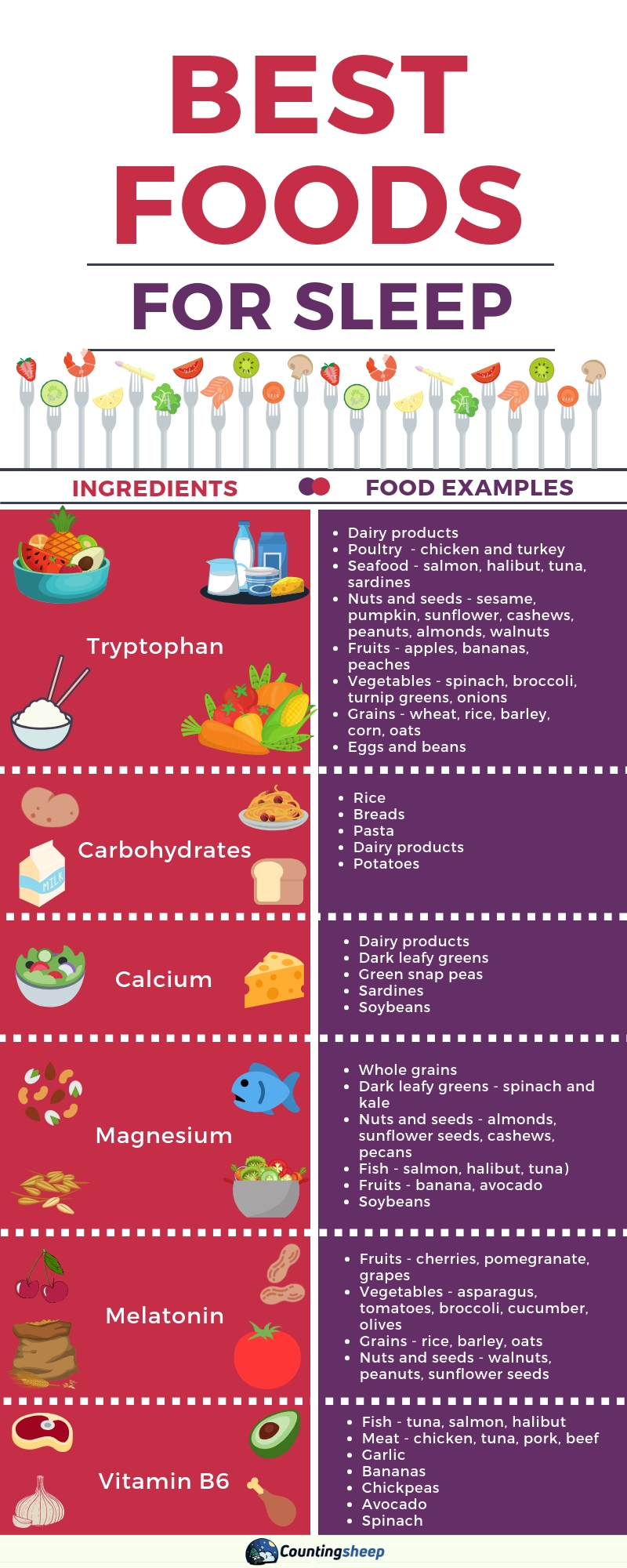
Why are Tryptophan-Rich Foods Good for Sleep?
Tryptophan is an amino acid that is a natural precursor to the neurotransmitter serotonin. Serotonin is later converted to melatonin, a neurotransmitter vital for regulating sleep. The most significant source of tryptophan is dairy products, eggs, poultry, and seafood. Since most proteins are rich in tryptophan, they should be easy to remember. If you are wondering what to eat at night when hungry, these are always a good choice for a bedtime snack. Foods rich in tryptophan (protein) are also one of the best foods to eat at night for weight loss.
Why are Carbohydrate-Rich Foods Good for Sleep?
Carbohydrates promote better sleep because they facilitate the production of tryptophan. Studies show that pairing carbohydrates with a healthy fat can make you sleepy. Research published in the American Journal of Clinical Nutrition indicates that carbohydrate-rich foods with a high glycemic index make you fall asleep faster. Carbohydrates are mostly found in bread, rice, pasta, and potatoes.
Why are Calcium-Rich Foods Good for Sleep?
Calcium not only helps you fall asleep faster but also helps you to stay asleep. This mineral promotes better sleep by assisting the brain in making melatonin. A lack of calcium can cause you to wake in the middle of the night and experience difficulties returning to sleep. Calcium-rich diets can help you alleviate the symptoms of insomnia. This mineral isn’t exclusive to dairy products, and can also be found in dark leafy greens. Dairy products are considered one of the best sleep inducers because they contain both tryptophan and calcium.
Why are Magnesium-Rich Foods Good for Sleep?
Magnesium is a very powerful mineral that is a natural relaxant and helps to deactivate adrenaline. Since it has a relaxing effect on your body and mind, it can help us to unwind and fall asleep faster. A lack of magnesium may cause both sleep onset and sleep maintenance insomnia. High sources or magnesium are also considered one of the best anti insomnia food and they can be found in foods such as dark leafy greens, nuts and seeds, avocado, fish and wheat germ.
Why are Melatonin-Rich Foods Good for Sleep?
Melatonin functions both as a hormone and a neurotransmitter. The pineal gland produces it, and it’s naturally regulated by light. Our body naturally produces melatonin, but it can also be found in many foods. What foods are high in melatonin? Mostly fruits and vegetables, grains, nuts and seeds.
According to a study published in the Journal of Medicinal Food, cherries are best fruit to eat before bed. Drinking 1 cup of tart cherry juice twice a day can reduce insomnia. Some studies also indicated that consuming walnuts may increase the overall levels of melatonin in your blood.
Why are B6-Rich Foods Good for Sleep?
Simply put, it helps the body to create neurotransmitters that further help the body to produce melatonin. Lack of vitamin B6 can lower the levels of serotonin in the body, and as a consequence, cause insomnia or other sleep disruptions. Highest sources of B6 are found in mean and fish, sunflower seeds, pistachio nuts, and fruits. One of the many uses of avocados is to induce sleep. Apart from avocado, bananas can also help you fall asleep.
Drinks that Help You Sleep
Apart from food, certain beverages can help you snooze better and without experiencing any disruptions. How to get to sleep when you can’t? The following drinks contain essential vitamins and minerals that promote better shuteye.
– Warm milk
– Almond milk
– Valerian tea
– Chamomile tea
– Tart cherry juice
– Passion fruit tea
– Peppermint tea
Can Drinking Milk before Bed Help You Sleep Better?
When you were a kid, your mother probably gave you a glass of warm milk before bed to help you sleep better. Although this may sound like old wives’ tale, it’s not. Studies have shown that drinking milk before bed can really help you snooze better because milk is rich in tryptophan and calcium. While tryptophan helps you to fall asleep, calcium makes sure you stay asleep during the entire night. The mere routine of drinking milk before bed also has an effect, because, over time, your brain starts associating this activity with sleep. Milk is the ultimate food for deep sleep. A warm cup of tea can also help to relax you and induce sleep.
Foods that Keep You Awake
Just as some foods and drinks can help you to sleep better, there are also foods and beverages you need to avoid before bedtime because they may rob you of sleep. Many of the foods that are on our list of foods that prevent sleep are healthy for you to eat, but are not recommended to be consumed before bed because they can disrupt sleep.
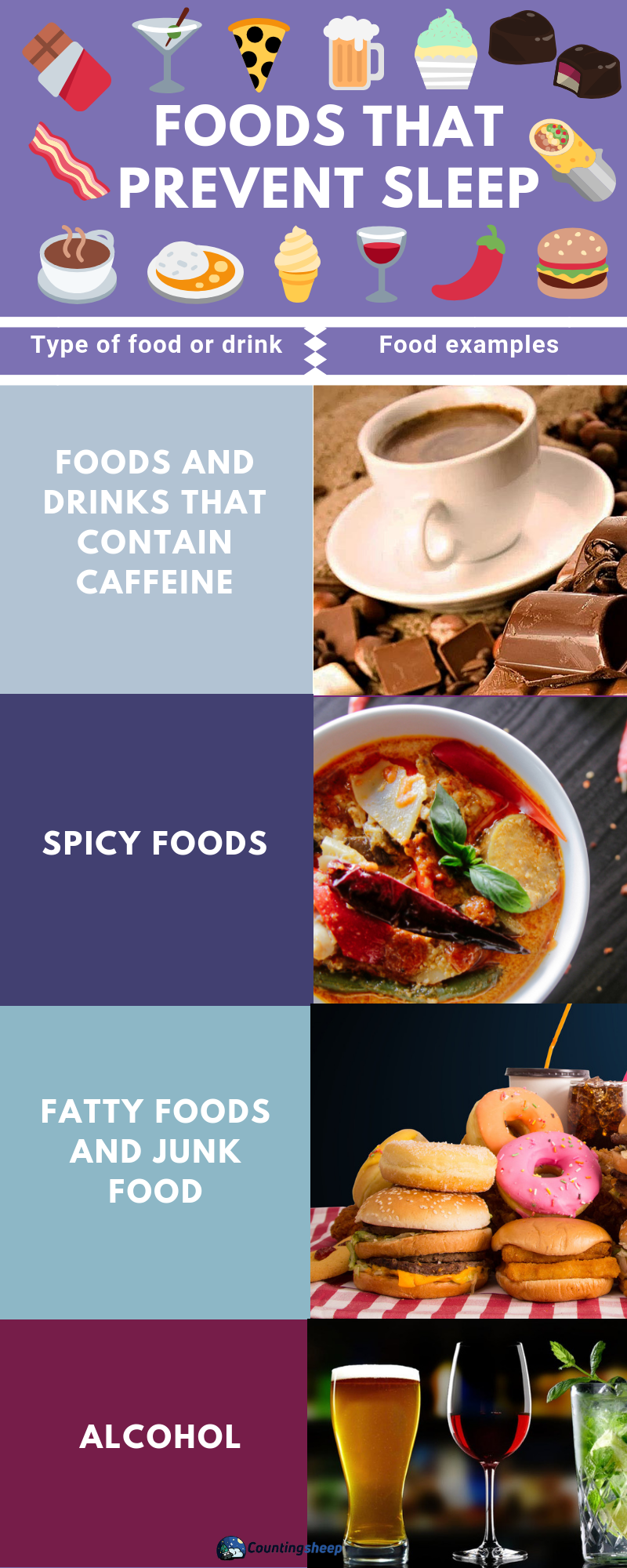
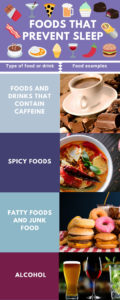
Foods and Drinks That Contain Caffeine
Coffee and energy drinks can give you a boost of energy when you are really feeling tired. However, since caffeinated beverages keep your mind active, you should avoid them after lunch and especially near bedtime. Foods such as dark chocolate are also high in caffeine and should be avoided late in the day.
Spicy Foods
Spicy food is very healthy and often delicious, but eating it close to bedtime is not a good idea because it may cause indigestion, heartburn and acid reflux. Heartburn gets even worse when you are lying down. Researchers believe that spicy food disrupts sleep because it contains capsaicin (typically found in chili peppers) that increases your internal body temperature. In order to fall asleep, your body temperature needs to be a bit lower than normal. Spicy foods also contain more fat which makes it harder for your body to process. Due to this, your body will focus on digestion instead of helping your brain to fall asleep.
Alcohol
Many people believe that alcohol can help you to fall asleep by making you feel drowsy. There are no alcoholic drinks that can help you sleep. However, although it can make you feel drowsy, and even if you fall asleep faster than usual, alcohol disrupts sleep, and it may prevent you from entering the deep stage of sleep.
Fatty Foods
Foods that are high in fat can disrupt sleep and your circadian rhythm. Researchers explain that a high fat diet disrupts the levels of orexin in your body, one of the neurotransmitters that help regulate your sleep and wake cycle. As a result, you will be sleepier during the day and hungrier at night. Consuming too many foods that are high in saturated fat may cause poor, fragmented sleep. Fat, apart from triggering digestion, also builds up the stomach acids, causing heartburn or acid reflux. Foods high in protein can disrupt sleep in the same manner as fatty foods.
Sugary Desserts and Junk Foods
Junk food will not only cause weight gain but may also disturb your sleep. Although these are the foods that make you sleepy after lunch, it doesn’t mean it can induce a healthy sleep. When you eat too much junk food or sugary desserts, your digestive system will not just spend the entire night breaking it down but over time, those foods will trigger late-night cravings.
Heavy Meals before Bedtime
Even if your diet is balanced and healthy, you should always avoid heavy meals close to bedtime. If you feel hungry close to bedtime, it is best to get a light snack such as a bowl of cereal, cheese, and crackers, or peanut butter on toast. These foods will induce sleep because they are rich in tryptophan and calcium. Apart from avoiding heavy meals, you should also avoid foods that contain water as well as drinking too much fluid close to bedtime. Watermelon and celery are natural diuretics, and consuming them before bedtime will lead to multiple unwanted bathroom trips.
Gastroesophageal Reflux Disease and Sleep
Symptoms of GERD usually worsen during the night. Acid reflux occurs when the stomach acid splashes back into your throat, causing heartburn, nighttime asthma, and difficulty swallowing. Lying down in bed with a full stomach will make things even worse. To alleviate the symptoms of GERD, apart from adjusting your sleeping position, you should also change your diet. For example, the largest meal you eat during the day should be at lunchtime, and you mustn’t eat at least 3 hours before bedtime. Caffeine, alcohol, and hot spices are foods that can trigger acid reflux symptoms and should definitely be avoided.
Sleep Problems and Diet
If you have troubles falling asleep, or staying asleep at night, you have to cut down on all foods and drinks that may disturb sleep. It’s important to avoid caffeine, alcohol, sugary and junk food particularly. Your dinner should be light and made of foods that are rich in carbohydrates and tryptophan. For example, eat a bowl of cereal, some yogurt or drink a warm glass of milk with honey. These light snacks should relax you and help you fall asleep, especially if they become a regular part of your bedtime routine. For proper sleep, it is best not to eat at least 3 hours before bedtime. It’s never a good idea to go to bed with a full stomach, especially if you have insomnia or other sleep issues.
If you practice good sleep hygiene and follow the recommended eating tips, but still experience sleep problems, you could be suffering from a sleep disorder. In this case, it is best to visit your physician or contact a sleep center to help you.
Numerous individuals find solace in music, particularly using it as a tool to transition into sleep after a stressful day. In the past, the benefits of music for promoting sleep lacked scientific evidence. However, new … Read more
Numerous individuals find solace in music, particularly using it as a tool to transition into sleep after a stressful day. In the past, the benefits of music for promoting sleep lacked scientific evidence. However, new research conducted by Tabitha Trahan at the University of Sheffield, UK has now provided solid proof that music indeed has the capability to facilitate sleep and protect against different types of disruptions that might interfere with it.

As we all are aware of, sleep loss is a severe problem that not only affects our physical and mental health but also has physical and economic consequences for the entire population and state. Research conducted by Tabitha Trahan indicates that music may serve as a cheap and completely natural (non-pharmaceutical) way to address our sleeping problems. The study required the participants to complete an online survey. The online poll scored musicality, sleep habits and required participants to openly reply what music helps them to fall asleep and why. The results were published in PLOS ONE, an open-access scientific journal, and clearly suggest many people in the UK use music as a sleep aid. This study helped to understand why people use music as a sleep aid and what music they believe work to address sleep problems.
In total, the respondents identified and described 14 musical genres comprising of 545 artists that help them to fall asleep. An interesting fact is that respondents that don’t have any sleep problems also use music in their everyday life to improve the quality of their sleep. Younger people with higher musical engagement are more likely to use music as a sleep aid. Based on open-text replies, the participants believe music both stimulates sleep and blocks internal or external sleep disruptors. Internal sleep disruptors can be described as anxiety, while external ones most likely involve noise.
The study wasn’t focused on drawing conclusions about music’s physiological and psychological effects and its effects on sleep but was instead aimed to investigate the participants’ belief about how music helped them sleep. Since the participants of the study were self-selected, it may be possible that the respondents were biased toward music users. However, the study still provides vital information and evidence that people use diverse types of music as a sleep aid. Music as a sleep aid isn’t only used for relaxation, but also for masking noise or unpleasant sounds, due to habit, passion for music, and lastly, mental distraction. Based on people’s motivation to reach for music as a sleep aid, we can also understand their reasons for finding it so compelling.
The content you have given does not include any specific text for rewording but rather outlines the framework for a webpage section created using the Divi Builder, which is a tool for building pages in … Read more
The content you have given does not include any specific text for rewording but rather outlines the framework for a webpage section created using the Divi Builder, which is a tool for building pages in WordPress. What you’ve provided describes the layout for a section, a row, and a column, which then leads to a text module. This is not actual textual content that can be reformulated. If you have any real text that requires rephrasing, kindly submit the text without including the HTML or Divi Builder’s shortcode, and I would be glad to help with your request.
A study carried out by Rice University, and Northwestern University has indicated that individuals who have recently lost a partner have a higher risk or experiencing sleep disturbances that may particularly bad for their heart. Grief leads to sleep disruptions that aggravate levels of inflammation in the body and increase the risk for cardiovascular illness.
The study is a part of a much larger project called HEART, and its results were published in Psychosomatic Medicine. In this research, scientists have compared analyzed the sleep habits and sleep disturbances of recently widowed people. Results of the study indicate that sleep disturbances and inflammation were 2 to 3 times higher in recent widows and widowers. The level of inflammation in the body was measured by measuring the levels of proinflammatory cytokines. Proinflammatory cytokines are well-known as short-term fighters of a disease, but they are also linked to long-term risk for severe health problems such as heart disease.

One of the authors of the study, Diana Chirinos, an assistant professor of preventive medicine at the Northwestern University Feinberg School of Medicine, started exploring this topic in her postdoctoral studies at the Rice Academy, and found out that bereaved individuals are overall more affected by the negative effects of poor sleep than people who are not grieving at the moment. The death of a spouse is as a very stressful event and requires a lot of time and emotional strength in order to be handled. It is entirely reasonable to experience sleep disturbances at that time. However, poor sleep is another major stress for the body. When you add poor sleep to an already stressful situation, you are doubling the stressor. As a result, your immune system will become over-activated and raise the levels of proinflammatory cytokines in your body.
Some studies in the past already showed that widowed people had higher levels of inflammation in their body and revealed that they are at a 41% higher risk of mortality. However, an interesting fact is that 53% of this increased risk is due to heart disease. Diana Chirinos and her fellow researchers wanted to identify the specific cause. This study has shown that grief is not the primary cause of this increased risk, but the sleep disruptions that arise from that grief.
Chris Fagundes, the principal investigator for Project HEART, said that this study is very important because it reveals how human activities and certain behaviors affect inflammation and how grief can impact our health. Further research aims to help come up with effective health interventions for those who have recently experienced a loss.
[/et_pb_text][/et_pb_column][/et_pb_row][/et_pb_section]
A new study, engaging 177,000 young learners, carried out by the American Academy of Sleep Medicine, has identified a link between a lack of adequate sleep in kids and teenagers, and a detrimental way of … Read more
A new study, engaging 177,000 young learners, carried out by the American Academy of Sleep Medicine, has identified a link between a lack of adequate sleep in kids and teenagers, and a detrimental way of living that includes poor dietary choices and heightened usage of digital screens.
The results of the study specifically link improper sleep with unhealthy eating habits such as skipping breakfast, fast-food consumption and consuming sweets on a daily basis. Poor sleep is also associated with increased screen time and being overweight or obese. The results were published in the October issues of the Journal of Clinical Sleep Medicine.

The senior author of the study, Labros Sidossis, Ph.D. at the Department of Kinesiology and Health at Rutgers University in New Brunswick, New Jersey, says that 40% of children in the study slept significantly less than recommended. Sleep experts at the American Academy of Sleep Medicine recommend that children aged from 6 to 12 must sleep 9 to 12 hours per night on a regular basis. Teenagers aged 13 to 18 require 8 to 10 hours of sleep per night. Sleeping less than the recommended amount may jeopardize children’s health. Poor sleep and bad sleeping habits were linked to poor dietary habits, obesity and increased screen time in both genders.
The participants of the study were required to complete electronic surveys at school which included providing information on their dietary habits, typical sleeping hours, physical activity, and sedentary activities. The participants of the study were children aged from 8 to 17. The results of the study show that children and teens who reported sleep less than 9 or 8 hours per night also had lower physical activity. Their physical education teachers obtained physical activity status and anthropometric fitness measurements.
Dr. Sidossis was surprised that aerobic fitness was associated with children’s sleep habits. Simply explained, better sleep habits are associated with higher levels of aerobic fitness. Since adequate sleep results in higher energy levels during the day, researchers believe that kids who sleep well are more physically active during the day. Poor sleep among school-aged children is a severe health problem in Westernized societies, and all findings aim to help parents, teachers and health professionals to identify particular sleeping problems and successfully promote strategies that will encourage healthier sleeping patterns and better sleeping habits.
Recent research has revealed that the mechanism which regulates sleep in fruit flies includes a component often found in energy drinks. Intriguingly, fruit flies exhibit a number of similarities to humans. They are active during … Read more
Recent research has revealed that the mechanism which regulates sleep in fruit flies includes a component often found in energy drinks. Intriguingly, fruit flies exhibit a number of similarities to humans. They are active during the day and rest at night, just like humans, and they show sleep behaviors that are remarkably similar to those observed in humans. The research carried out at the Florida Atlantic University identified a new gene and the way it controls sleep in fruit flies through the regulation of taurine – an ingredient frequently present in energy drinks. Taurine also plays a significant role in the human brain, where its concentration rises in the blood and urine of people who are sleep deprived.
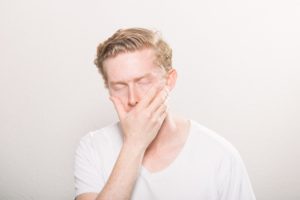
Every individual is aware of the importance of sleep for our physical and mental wellbeing. Rest is vital for immune function, metabolism, brain and muscle repair, learning and memory. Unfortunately, 30% of people will experience a sleep disorder throughout their life. All sleep disorders, no matter how harmless they seem, should be taken seriously because they are associated with a number of severe diseases such as diabetes, cardiovascular disease, and obesity.
In the past, scientists have believed that the glial cells only support neurons within the brain. However, new studies have revealed that these cells are essential for sleep regulation. The research teams of Florida Atlantic University and McGill University in Quebec had studied the fruit fly and discovered that glial cells and their ability to manage taurine are vital for regulating sleep. The fruit fly was chosen because it shares 75% of genes that cause various illnesses in humans, and although because we display similar behavioral and physiological characteristics of sleep. The study aimed to identify new genes that affect sleep and wakefulness in fruit flies. Scientists have uncovered a gene that is responsible for the membrane transport protein. This gene is called excitatory amino acid transporter 2 or shortly Eaat2.
Eaat2 increases wakefulness in fruit flies and actually limits their length and intensity of sleep. Sleep is regulated by controlling the movement of taurine into the glia. We already know that taurine is elevated in the blood and urine of sleep-deprived individuals, but we don’t know if taurine levels change after sleep deprivation. The authors of the study also found that disruption of Eaat2 in fruit flies causes excessive daytime sleepiness.
Since more than 70 millions of Americans suffer from sleep disorders, this kind of research is essential to raise awareness of the importance of sleep deprivation as a global issue and about understanding the fundamental mechanism of sleep. The identification of Eaat2 as a sleep regulator will help scientists to study further sleep regulation, sleep disorder treatment, and changes in metabolism that depend on sleep.
The scientists found that Eaat2 works only in specific glial cells of the fly brain. Glial cells play an important regulatory role and don’t just control the wakefulness of the fly, but also circadian rhythms. As mentioned before, Eaat2 regulates sleep by transporting taurine. Increased levels of taurine in the brain lead to excessive daytime sleepiness, and this claim was confirmed by an individual experiment which involved feeding fruit flies taurine. Future research aims to discover how transport of taurine to and from glial cells affects sleep in humans.
Recent research underscores the critical role of good sleep practices in mental health. Experts in medicine and science have identified links between sleep disorders and a range of mental health issues, such as anxiety, depression, … Read more
Recent research underscores the critical role of good sleep practices in mental health. Experts in medicine and science have identified links between sleep disorders and a range of mental health issues, such as anxiety, depression, dementia, and brain injuries. Previously, these sleep problems were often considered just symptoms of pre-existing mental health conditions, yet today’s findings suggest that poor sleep can actually exacerbate neurological disorders. This information comes from research presented by the Society for Neuroscience during their yearly gathering on November 5th, 2018. The Society for Neuroscience is renowned as a leading and extensive source for news related to neuroscience and mental health.

The study aims to understand better the brain mechanisms linked to disrupted sleep and irregular circadian rhythms, and hopefully, discover new ways to prevent and alleviate disorders that are affected by irregular circadian rhythms such as anxiety, depression, Alzheimer’s and dementia. Even though scientists still don’t have a clear understanding of how sleep exacerbates certain brain disorders, the research emphasizes the importance of prioritizing healthy and regular sleep.
At the annual meeting of the Society for Neuroscience, researchers have, among other topics, studied and presented the impact of concussions after more extended periods of sleep deprivation, and found out that brain injuries negatively affect circadian rhythms. The brain mechanisms which may worsen anxiety in sleep-deprived individuals were also presented. More research has to be conducted, but studies so far indicate that deep slow-wave sleep is required to calm the overactive regions of the mind. Lastly, neuroscientists have discovered that astrocytes, a circadian clock gene, play an important role in Alzheimer’s pathology. Disruption of the circadian rhythm on a cellular level can lead to neuroinflammation and exacerbate mental disorders such as Alzheimer’s.
Among other findings, all studies presented at this year’s annual meeting help us understand why sleep is disrupted in so many patients suffering from mental or brain issues. Treatments that regulate circadian rhythms, such as sleep-focused therapies may be beneficial in preventing a number of brain disorders, including Alzheimer’s disease and anxiety. This furthermore emphasizes the vital role of sleep for our physical and mental wellbeing.